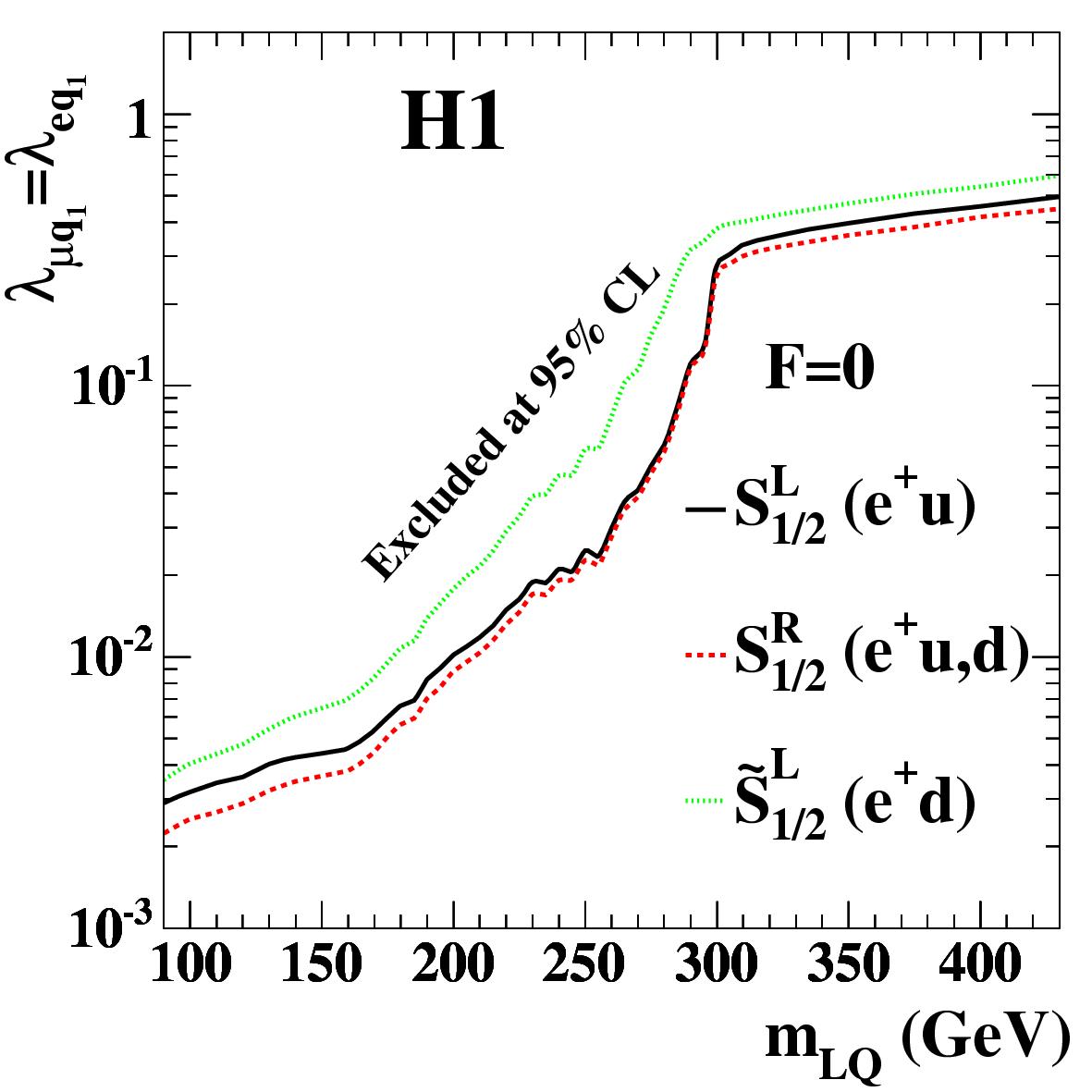
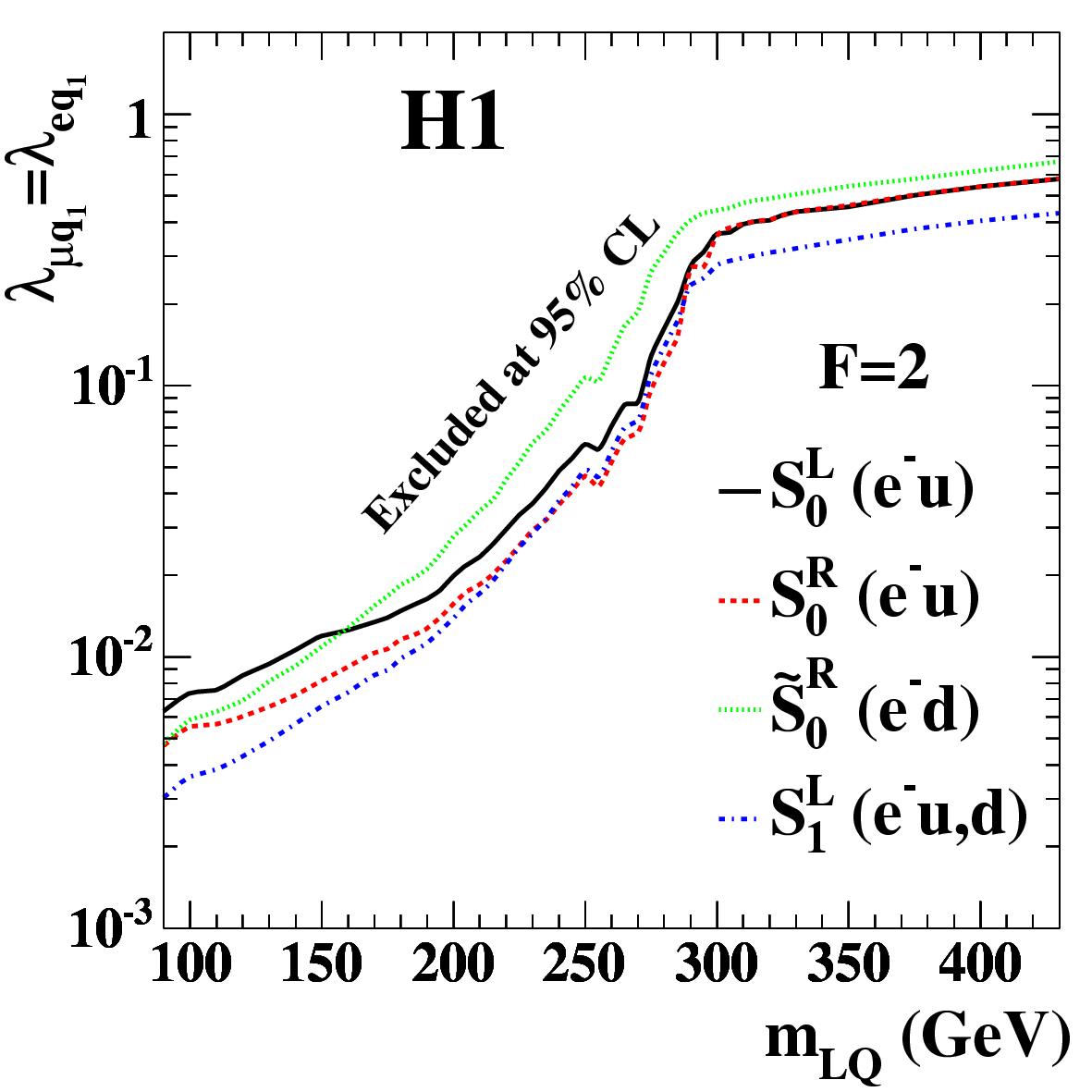
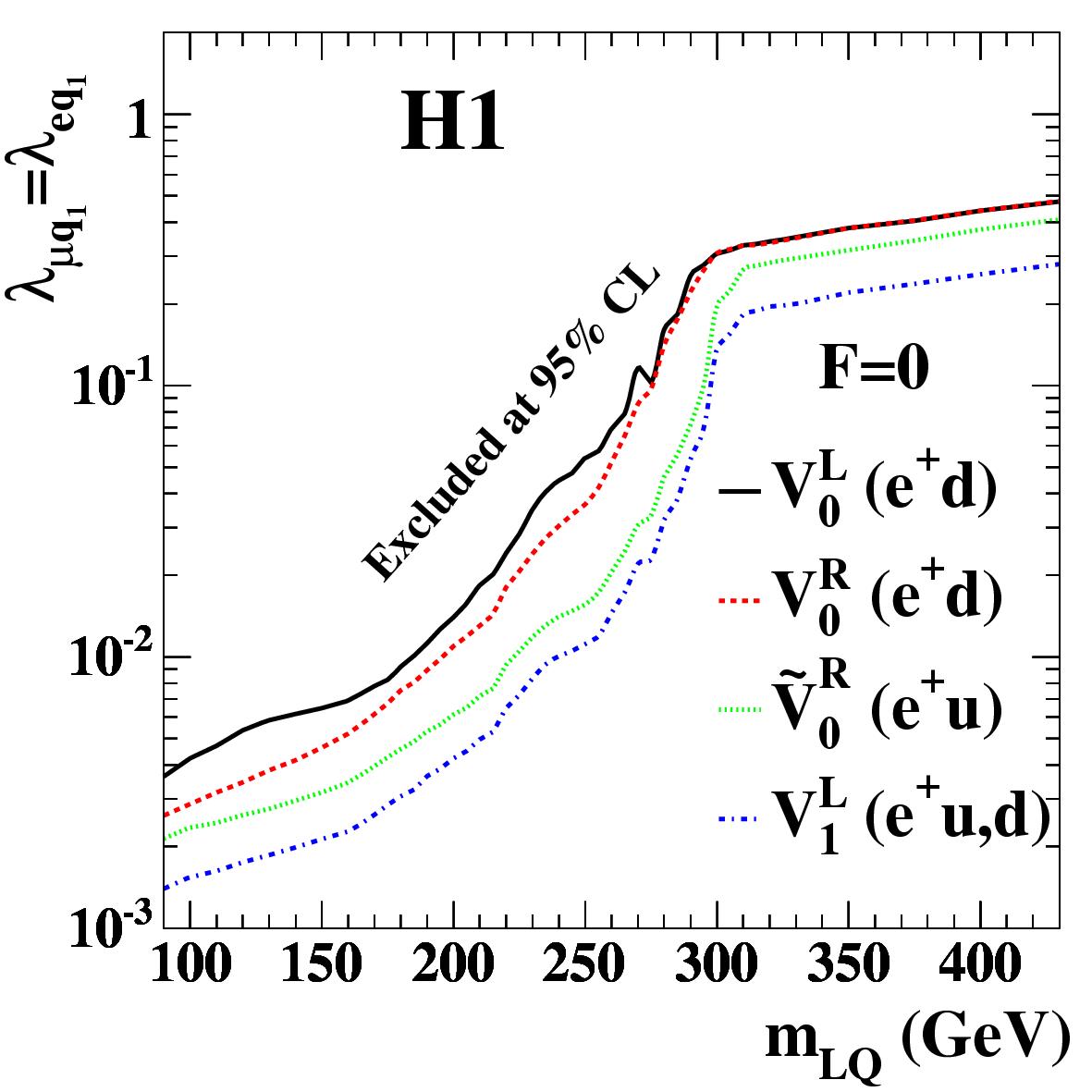
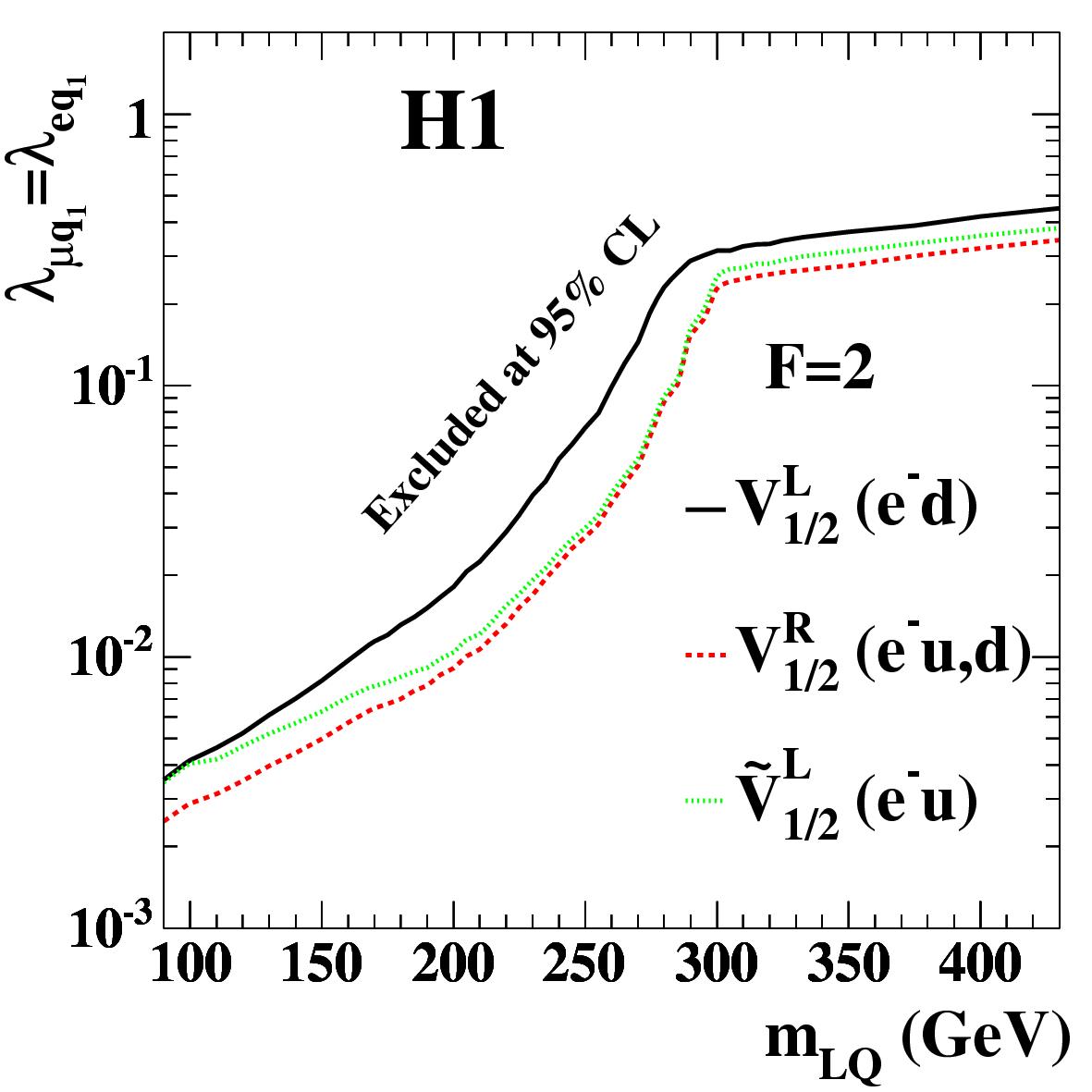
Search for Lepton Flavour Violation in ep Collisions at HERAThe H1 Collaboration |
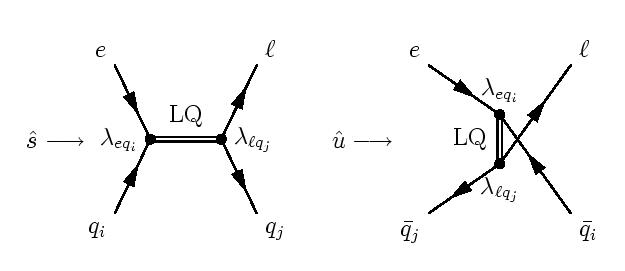
The ep collider HERA offers the unique possibility to search for the resonant production of new particles which couple directly to a lepton and a parton. Leptoquarks (LQs), colour triplet bosons, which appear naturally in various unifying theories beyond the Standard Model (SM) are such an example. At HERA, leptoquarks could be singly produced by the fusion of the initial state lepton of energy 27.6 GeV with a quark from the incoming proton of energy up to 920 GeV, as shown on the left.
In the framework of the Buchmüller-Rückl-Wyler (BRW) effective model, LQs are classified into 14 types with respect to the quantum numbers spin, isosp in and chirality. Leptoquarks carry both lepton (L) and baryon (B) quantum numbers. The fermion number F = L + 3B is assumed to be conserved, taking values of F = 2 for e-q processes and F = 0 for e+q processes. The latest H1 publication on the search for such first generation leptoquarks can be found here.
In the SM particle interactions conserve lepton flavour, although there is no underlying symmetry supporting this feature. The observation of such effects would clearly indicate new phenomena beyond the SM. In the ep collisions at HERA, lepton flavour violating (LFV) processes ep → μX or ep → τX would lead to final states with a muon or a tau and a hadronic system X. The LFV process can proceed via the exchange of a second or third generation LFV leptoquark (LQ) in many extensions of the SM such as grand unified theories, supersymmetry, compositeness and technicolor. A general extension of the BRW model allows for the decay of LQs to final states containing a lepton of a different flavour, i.e. μ or τ and a jet. Non-zero couplings λeqi to an electron-quark pair and λμqj (λτqj) to a muon(tau)-quark pair are assumed, where the indices i and j represent quark generation indices, such that λeqi denotes the coupling of an electron to a quark of generation i and λlqj is the coupling of the outgoing lepton l to a quark of generation j.

 |

 |
In this paper a search for LFV phenomena is performed in ep collision data recorded during the years 1998-2000 by the H1 experiment, corresponding to an integrated luminosity of 66.5 pb-1 for e+p collisions and 13.7 pb-1 for e-p collisions at a centre-of-mass energy √s = 319 GeV. The present results supercede those derived in previous searches at the H1 experiment using e+p collisions at energy √s = 300 GeV.
First generation LQ decays lead to final states similar to those of deep-inelastic scattering (DIS) neutral current (NC, ep → eX) and charged current (CC, ep → νX) interactions. In this analysis, these processes contribute as background, by mimicking the final state signature of signal events. Additional background arises from photoproduction (γp → X), lepton-pair (ep → el+l-X) and W production (ep → eWX) events.
The search for muon signal events (ep → μX), where the LQ couples to the first and second lepton generation, is performed by requiring a muon back to back with the hadronic system in the transverse plane. However, the event should also have large missing calorimeteric transverse momentum - muons typically deposit only a small fraction of their energy in the calorimeter. The muon is additionally required to be well isolated from the nearest jet or track. These selection criteria greatly supress the NC component of the background rate, which is mainly composed of muon pair-production and the muonic decays of W bosons.
The search for tau signal events (ep → τX), where the LQ couples to the first and third lepton generation, is performed in three tau decay channels: electronic, muonic and hadronic. Electronic decays (τ → eνeντ) have a topology similar to high Q2 NC events, except for missing transverse present due to the escaping neutrinos, which is exploited in order to reduce this background. Muonic decays (τ → μνμντ) result in similar final states described above in the search for muon signal events, and therefore the same selection stategy is employed. Hadronic decays of the tau lead to a high transverse momentum, narrow jet resulting in a signal topology of a di-jet event with no leptons. These events are selected using a neural net algorithm to separate and identify those jets originating from tau decays from those in NC DIS and photoproduction events, the main background in this channel.
The analysis finds no evidence for LFV LQ production. No data candidate is recorded in the e-p data and one candidate in the e+p data, in agreement with the SM predictions. As no signal is observed, exclusion limits at 95% confidence level are derived on the couplings λμq and λτq of all 14 LQ types as a function of LQ mass, assuming λeq = λμq = λτq. The limits on λμq are shown on this page, for F = 0 (top) and F = 2 (bottom) scalar and vector leptoquarks. The constraints are set combining the LFV search with the search for first generation LQs. The limits are a factor of 2 to 4 more stringent and extend beyond the domain in LQ mass excluded by previous searches performed by the H1 experiment. Exclusion limits on several scenarios of LFV transitions of the kind eq → τq are more stringent than limits from searches for certain rare meson or tau decays. Assuming a coupling of electromagnetic strength, leptoquarks mediating lepton avour violating processes e → μ and e → τ can be ruled out up to masses of 459 GeV and 379 GeV, respectively.